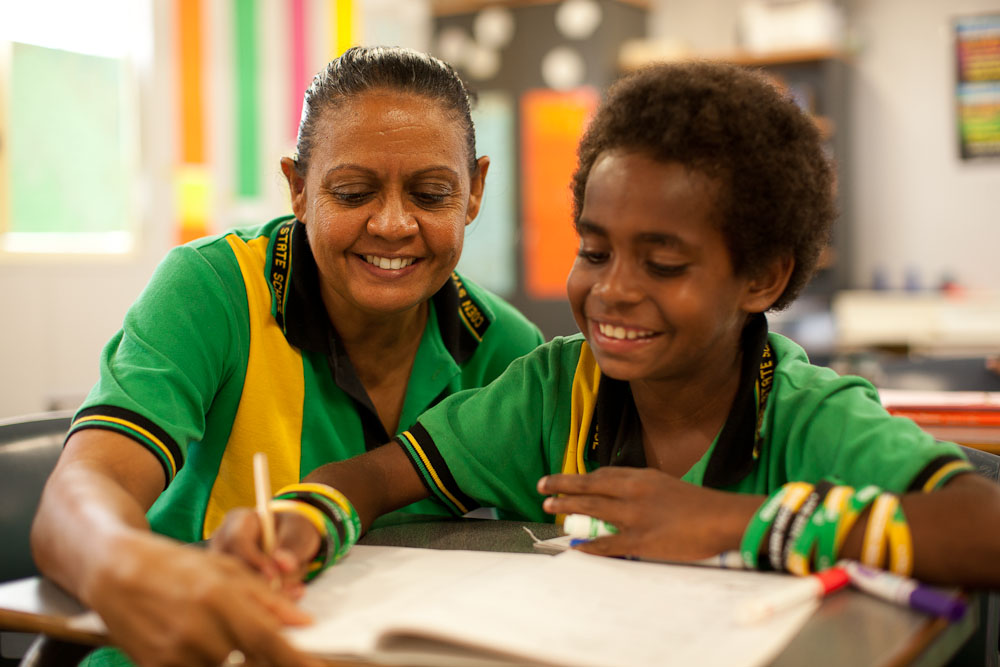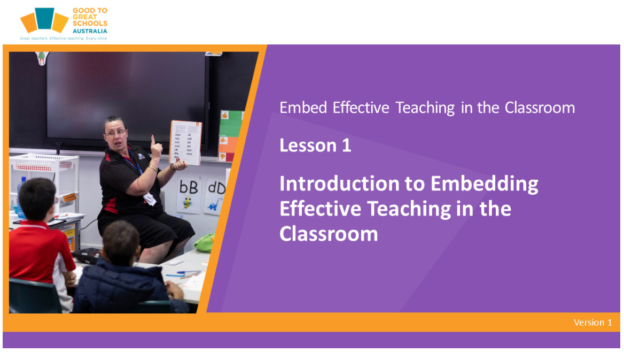
Course Module
Embed Effective Teaching in the Classroom
Overview
Embed Effective Teaching in the Classroom is a specialised course designed for educators who have already completed the Learn Effective Teaching Essentials module. This course serves as a continuation, leveraging the foundational knowledge acquired previously. Participants are presumed to possess a fundamental understanding of effective teaching techniques and are actively applying them in their teaching practices.
The course focuses on deepening educators’ understanding and implementation of effective teaching within the classroom context. It aims to equip teachers with advanced strategies and methodologies to seamlessly integrate effective teaching techniques into their daily instruction. By delving into more nuanced aspects of effective teaching, educators will gain insights into optimising student engagement, fostering a conducive learning environment, and maximising student learning outcomes. Throughout the course, participants will explore innovative approaches to tailor effective teaching techniques to diverse student needs and learning styles. Emphasis is placed on practical application, with opportunities for teachers to reflect on their current practices and refine their teaching approaches accordingly. By the end of the course, educators will have honed their skills to the point where effective teaching techniques become ingrained and instinctive, enhancing overall student achievement and classroom success.
Learning intents
What’s included?
- Overarching intents (incorporated into every lesson)
- Implement own professional learning plan based on participation in training and coaching. (3.5.05)
- Lesson 1: Introduction to Embedding Effective Teaching in the Classroom
- Lesson 2: Placement Assessments and Preparing for Learning
- Implement classroom organisation strategies to engage students in their learning and good use of instructional time. (3.1.11)
- Implement lesson sequences with fidelity while maintaining student engagement and promoting learning. [MTP3.1.09]
- Plan instructional day around appropriate instructional programs. (3.1.10)
- Use scope and sequence charts and in-program mastery test results to set explicit, challenging, and achievable learning goals for all students. [MTP3.1.08]
- Plan explicit, challenging and achievable learning goals for all students. (3.1.08)
- Evaluate classroom organisation and use of time and use information to provide ongoing improvement. (3.1.11)
- Plan group instruction based on mastery data and program guidelines. (3.2.08)
- Lesson 3: Teach fluently and model techniques part 1
- Implement all parts of direct and explicit instruction lessons. (3.2.07)
- Implement plan to facilitate routines, orderly transitions, and bell to bell teaching. (3.4.07)
- Implement lesson sequences with fidelity, maintaining student engagement and promoting learning. (3.1.09)
- Select and use appropriate instructional programs and apply effective teaching strategies to develop knowledge and skills. Use effective teaching techniques skillfully to develop problem solving and critical and creative thinking. Participate in program practice sessions to master teaching strategies. (3.1.10)
- Implement direct and explicit instruction lessons with fidelity. (3.2.08)
- Implement effective teaching techniques to develop problem solving skills in students. (3.1.10)
- Plan lesson presentation using direct and explicit instruction teaching techniques. (3.2.07)
- Review own delivery of direct and explicit instruction lessons, reflect on personal effectiveness, and articulate and set improvement actions. (3.2.07)
- Implement direct and explicit instruction literacy and numeracy programs using direct and explicit instruction techniques with skill. (3.2.11)
- Lesson 4: Modeling techniques part 2
- Plan how to group students and maximise instructional time to manage classroom activities. (3.4.07)
- Review behavioural expectations and revise, review or re-teach if necessary. (3.4.07)
- Implement direct and explicit instruction literacy and numeracy programs using direct and explicit instruction techniques with skill. (3.2.11)
- Select and use appropriate instructional programs and apply effective teaching strategies to develop knowledge and skills. Use effective teaching techniques skillfully to develop problem solving and critical and creative thinking. Participate in program practice sessions to master teaching strategies. (3.1.10)
- Implement direct and explicit instruction lessons with fidelity. (3.2.08)
- Implement effective teaching techniques to develop problem solving skills in students. (3.1.10)
- Plan lesson presentation using direct and explicit instruction teaching techniques. (3.2.07)
- Review own delivery of direct and explicit instruction lessons, reflect on personal effectiveness, and articulate and set improvement actions. (3.2.07)
- Implement direct and explicit instruction literacy and numeracy programs using direct and explicit instruction techniques with skill. (3.2.11)
- Lesson 5: Lead techniques part 1
- Plan instructional time to ensure students develop strong literacy, numeracy and behaviour skills. (3.2.11)
- Implement direct and explicit instruction literacy and numeracy programs using direct and explicit instruction techniques with skill. (3.2.11)
- Select and use appropriate instructional programs and apply effective teaching strategies to develop knowledge and skills. Use effective teaching techniques skillfully to develop problem solving and critical and creative thinking. Participate in program practice sessions to master teaching strategies. (3.1.10)
- Implement direct and explicit instruction lessons with fidelity. (3.2.08)
- Implement effective teaching techniques to develop problem solving skills in students. (3.1.10)
- Plan lesson presentation using direct and explicit instruction teaching techniques. (3.2.07)
- Review own delivery of direct and explicit instruction lessons, reflect on personal effectiveness, and articulate and set improvement actions. (3.2.07)
- Implement direct and explicit instruction literacy and numeracy programs using direct and explicit instruction techniques with skill. (3.2.11)
- Lesson 6: Lead techniques Part 2
- Implement effective teaching techniques to develop problem solving skills in students. (3.1.10)
- Implement direct and explicit instruction literacy and numeracy programs using direct and explicit instruction techniques with skill. (3.2.11)
- Select and use appropriate instructional programs and apply effective teaching strategies to develop knowledge and skills. Use effective teaching techniques skillfully to develop problem solving and critical and creative thinking. Participate in program practice sessions to master teaching strategies. (3.1.10)
- Implement direct and explicit instruction lessons with fidelity. (3.2.08)
- Implement effective teaching techniques to develop problem solving skills in students. (3.1.10)
- Plan lesson presentation using direct and explicit instruction teaching techniques. (3.2.07)
- Review own delivery of direct and explicit instruction lessons, reflect on personal effectiveness, and articulate and set improvement actions. (3.2.07)
- Implement direct and explicit instruction literacy and numeracy programs using direct and explicit instruction techniques with skill. (3.2.11)
- Lesson 7: Independent work
- Plan independent work that promotes student learning. (3.1.09)
- Review student work daily to ensure all students are at mastery. (3.1.09)
- Evaluate independent work to ensure alignment with lesson outcomes. (3.1.09)
- Plan independent work based on direct and explicit instruction program concepts. (3.1.11)
- Review student independent work to ensure students are engaging in the learning. (3.1.11)
- Select and use appropriate instructional programs and apply effective teaching strategies to develop knowledge and skills. Use effective teaching techniques skillfully to develop problem solving and critical and creative thinking. Participate in program practice sessions to master teaching strategies. (3.1.10)
- Implement direct and explicit instruction lessons with fidelity. (3.2.08)
- Implement effective teaching techniques to develop problem solving skills in students. (3.1.10)
- Plan lesson presentation using direct and explicit instruction teaching techniques. (3.2.07)
- Review own delivery of direct and explicit instruction lessons, reflect on personal effectiveness, and articulate and set improvement actions. (3.2.07)
- Implement direct and explicit instruction literacy and numeracy programs using direct and explicit instruction techniques with skill. (3.2.11)
- Lesson 8: Program Assessments
- Review student mastery of literacy, numeracy and behaviour skills using data and apply remedies as recommended in program. (3.2.11)
- Review mastery test data to determine individual and group mastery. (3.6.06)
- Plan instructional time to implement mastery tests as indicated in the program. (3.6.06)
- Implement in-program and out of program assessments to evaluate student mastery levels. (3.6.06)
- Evaluate next steps for groups, based on mastery test data and in collaboration with the Instruction Coach. (3.6.06)
- Evaluate group mastery and progress towards learning goals weekly, setting new goals as needed in collaboration with the Instruction Coach. (3.1.08)
- Lesson 9: Differentiation/RTI
- Implement re-teaching or skipping of direct instruction lessons, based on group mastery data, and in collaboration with Instruction Coach. (3.1.08)
- Review direct instruction student mastery data daily to ensure groups stay at mastery. (3.1.08)
- Review explicit instruction student mastery data daily to ensure groups stay at mastery. (3.1.08)
- Evaluate mastery data to set goals and provide focus for weekly practice sessions. (3.1.10)
- Plan instructional improvement that responds to specific needs of classroom cohort. (3.3.07)
- Implement and monitor instructional improvement classroom plan so that it meets the needs of all students in the classroom. (3.3.07)
- Review own delivery of plan, reflect on personal effectiveness, and articulate and set improvement actions. (3.3.07)
- Evaluate (using data, information and stories) student results and report to school leadership and colleagues on the impact, learnings and recommendations. (3.3.07)
- Plan interventions (within curricula) and non-curricular interventions (e.g., increasing instructional time) to modify teaching practise based on student assessment data from informal in-program assessments and related independent progress monitoring. (3.6.09)
- Lesson 10: Parent engagement
- Create a broad range of strategies for involving parents/carers in the educative process including providing background information on effective teaching and providing appropriate home practice opportunities that are appropriate to each family’s unique nee ds and circumstances. (3.1.14)
- Plan how to positively engage parents in their children’s work to motivate and maximise children’s learning. (3.8.05) Plan with families that require support to reach students’ development milestones. (3.8.07)

Prerequisite
- Learn Effective Teaching Essentials

Assessment
- Test: Knowledge and skills taught in the lessons.

Certification
Participants are eligible for certification based on completion of all activities and tests in the module.
- Certificate of Completion: Complete online training and knowledge and skills tests.



Responses